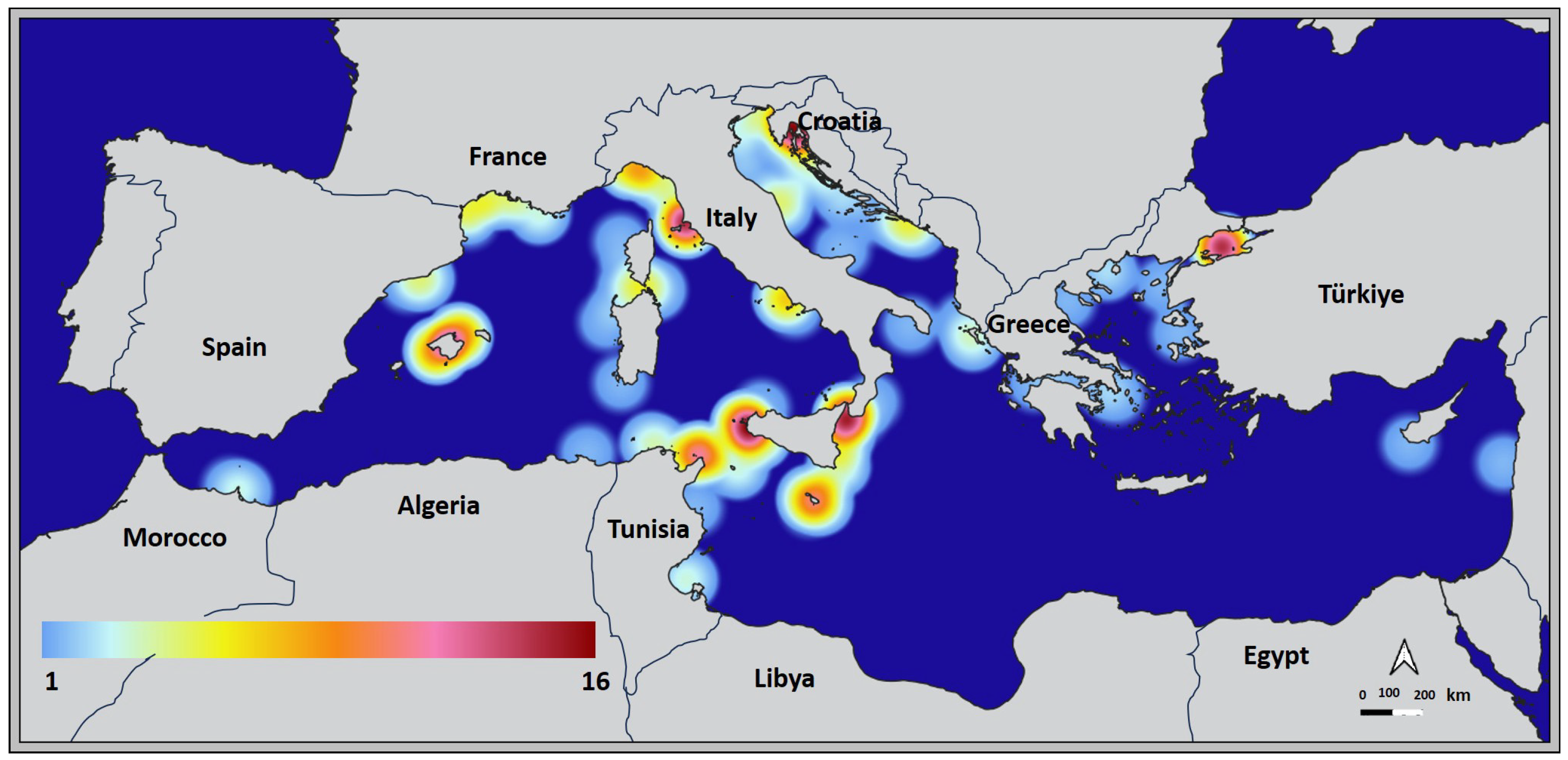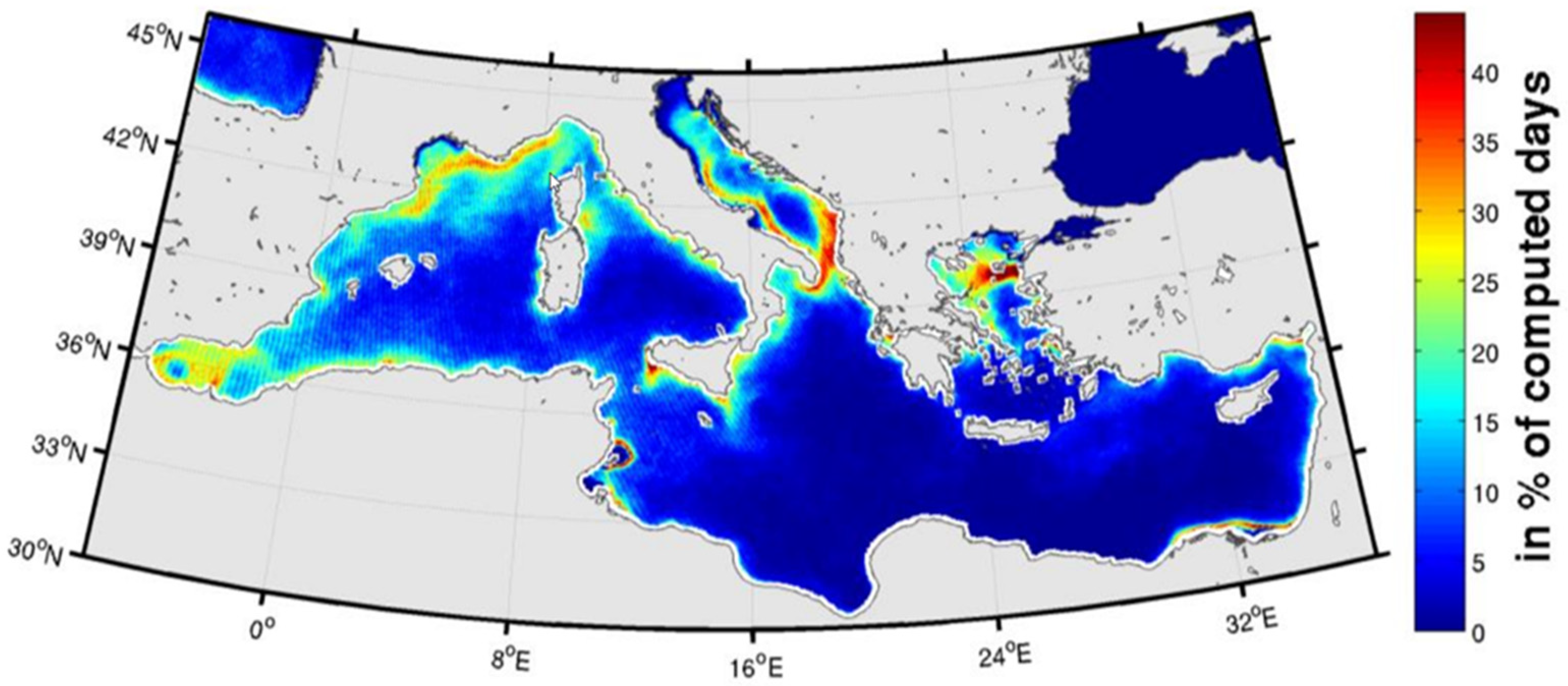Decreasing Trend of Great White Shark Carcharodon carcharias Records in the Mediterranean: A Significant Population Loss or Shifts in Migration Patterns?
Abstract
1. Introduction
2. Materials and Methods
2.1. Study Area
2.2. Great White Shark Database
2.3. Data Analysis
3. Results and Discussion
4. Conclusions
Author Contributions
Funding
Data Availability Statement
Conflicts of Interest
References
- Compagno, L.J.V. Sharks of the World: An Annotated and Illustrated Catalogue of Shark Species Known to Date. Volume 2. Bullhead, Mackerel and Carpet Sharks (Heterodontiformes, Lamniformes and Orectolobiformes); FAO Species Catalogue for Fishery Purposes No. 1; FAO: Rome, Italy, 2001; Volume 2, 269p. [Google Scholar]
- Ebert, D.A.; Dando, M. Field Guide to Sharks, Rays & Chimaeras of Europe and the Mediterranean; Princeton University Press: Woodstock, UK, 2021; 384p. [Google Scholar]
- Huveneers, C.; Apps, K.; Becerril-García, E.E.; Bruce, B.; Butcher, P.A.; Carlisle, A.B.; Chapple, T.K.; Christiansen, H.M.; Cliff, G.; Curtis, T.H.; et al. Future research directions on the “elusive” white shark. Front. Mar. Sci. 2018, 5, 416427. [Google Scholar] [CrossRef]
- Soldo, A.; Jardas, I. Large sharks in the Eastern Adriatic. In Proceedings of the 4th European Elasmobranch Association Meeting, Santiago de Compostela, Spain, 11–13 September 2002; Vacchi, M., La Mesa, G., Serena, F., Séret, B., Eds.; Icram, Arpat & Sfi.: Livorno, Italy, 2002; pp. 141–155. [Google Scholar]
- Soldo, A.; Jardas, I. Occurrence of Great White Shark, Carcharodon carcharias (Linnaeus, 1758) and Basking Shark, Cetorhinus maximus (Gunnerus, 1765) in the Eastern Adriatic and their protection. Period. Biol. 2002, 104, 195–201. [Google Scholar]
- Morey, G.; Martínez, M.; Massutí, E.; Moranta, J. The occurrence of white sharks, Carcharodon carcharias, around the Balearic Islands (Western Mediterranean Sea). Environ. Biol. Fish. 2003, 68, 425–432. [Google Scholar]
- Bradai, M.N.; Saidi, B. On the occurrence of the great white shark (Carcharodon carcharias) in Tunisian coasts. Rapp. Comm. Int. Mer. Médit. 2013, 40, 489. [Google Scholar]
- Storai, T.; Cristo, B.; Zuffa, M.; Zinzula, L.; Floris, A.; Campanile, A.T. The Sardinian large elasmobranch database. Cybium 2006, 30, 141–144. [Google Scholar]
- Maliet, V.; Reynaud, C.; Capapé, C. Occurrence of great white shark, Carcharodon carcharias (Elasmobranchii: Lamniformes: Lamnidae), off Corsica (northern Mediterranean): Historical and contemporary records. Acta Ichthyol. Piscat. 2013, 43, 323–326. [Google Scholar] [CrossRef]
- Kabasakal, H.; Bayrı, E.; Alkan, G. Distribution and status of the great white shark, Carcharodon carcharias (Linnaeus, 1758), in Turkish waters: A review and new records. Ann. Ser. Hist. Nat. 2022, 32, 325–342. [Google Scholar]
- Fergusson, I.K. Distribution and autecology of the white shark in the eastern North Atlantic Ocean and the Mediterranean Sea. In Great White Sharks: The Biology of Carcharodon carcharias; Klimley, A.P., Ainley, D.G., Eds.; Academic Press: San Diego, CA, USA, 1996; pp. 321–345. [Google Scholar]
- De Maddalena, A.; Heim, W. Mediterranean Great White Sharks: A Comprehensive Study Including All Recorded Sightings; McFarland: Jefferson, NC, USA, 2012; 242p. [Google Scholar]
- Boldrocchi, G.; Kiszka, J.; Purkis, S.; Storai, T.; Zinzula, L.; Burkholder, D. Distribution, ecology, and status of the white shark, Carcharodon carcharias, in the Mediterranean Sea. Rev. Fish Biol. Fish. 2017, 27, 515–534. [Google Scholar] [CrossRef]
- Moro, S.; Jona-Lasinio, G.; Block, B.; Micheli, F.; De Leo, G.; Serena, F.; Bottaro, M.; Scacco, U.; Ferretti, F. Abundance and distribution of the white shark in the Mediterranean Sea. Fish Fish. 2020, 21, 338–349. [Google Scholar] [CrossRef]
- Casey, J.G.; Pratt, H.L., Jr. Distribution of the white shark, Carcharodon carcharias, in the western North Atlantic. Mem. South. Calif. Acad. Sci. 1985, 9, 2–14. [Google Scholar]
- Soldo, A.; Bakiu, R. Additional historical records of the great white shark, Carcharodon carcharias (Lamniformes: Lamnidae) in the eastern Adriatic: Updating regional occurrence of a critically endangered shark. Ann. Ser. Hist. Nat. 2024, 34, 11–20. [Google Scholar]
- Dulvy, N.K.; Ellis, J.R.; Goodwin, N.B.; Grant, A.; Reynolds, J.D.; Jennings, S. Methods of assessing extinction risk in marine fishes. Fish Fish. 2004, 5, 255–276. [Google Scholar] [CrossRef]
- McPherson, J.M.; Myers, R.A. How to infer population trends in sparse data: Examples with opportunistic sighting records for great white sharks. Divers. Distrib. 2009, 15, 880–890. [Google Scholar] [CrossRef]
- Soldo, A.; Dulčić, J. New record of a great white shark, Carcharodon carcharias (Lamnidae) from the eastern Adriatic Sea. Cybium 2005, 29, 89–90. [Google Scholar]
- Soldo, A.; Peirce, R. Shark chumming in the eastern Adriatic. Ann. Ser. Hist. Nat. 2005, 15, 203–208. [Google Scholar]
- Micarelli, P.; Reinero, F.R.; Marsella, A.; Vernelli, E.; Vittorini, E.; Monteleone, L.; Vailati, M.; Marsili, L.; Tinti, F.; Sperone, E. Attempts to locate and sample the white shark, Carcharodon carcharias (Lamniformes: Lamnidae), along the Italian coasts in the Mediterranean Sea. Acta Adriat. 2023, 64, 181–186. [Google Scholar] [CrossRef]
- Ferretti, F.; Shea, B.D.; Gambardella, C.; Jenrette, J.F.; Moro, S.; Echwikhi, K.; Schallert, R.J.; Gallagher, A.J.; Block, B.A.; Chapple, T.K. On the tracks of white sharks in the Mediterranean Sea. Front. Mar. Sci. 2024, 11, 1425511. [Google Scholar] [CrossRef]
- Jenrette, J.F.; Jenrette, J.L.; Truelove, N.K.; Moro, S.; Dunn, N.I.; Chapple, T.K.; Gallagher, A.J.; Gambardella, C.; Schallert, R.; Shea, B.D.; et al. Detecting Mediterranean white sharks with environmental DNA. Oceanography 2023, 36 (Suppl. 1), 87–89. [Google Scholar] [CrossRef]
- Gubili, C.; Bilgin, R.; Kalkan, E.; Karhan, S.Ü.; Jones, C.S.; Sims, D.W.; Kabasakal, H.; Martin, A.P.; Noble, L.R. Antipodean white sharks on a Mediterranean walkabout? Historical dispersal leads to genetic discontinuity and an endangered anomalous population. Proc. R. Soc. B 2011, 278, 1679–1686. [Google Scholar] [CrossRef]
- Soldo, A.; Bradai, M.N.; Walls, R.H.L. Carcharodon carcharias (Mediterranean Assessment). IUCN. 2016. Available online: https://www.iucnredlist.org/species/3855/16527829 (accessed on 1 September 2025).
- Reed, J.M. Using statistical probability to increase confidence of inferring species extinction. Conserv. Biol. 1996, 10, 1283–1285. [Google Scholar] [CrossRef]
- Storai, T.; Zinzula, L.; Repetto, S.; Zuffa, M.; Morgan, A.; Mandelman, J. Bycatch of large elasmobranchs in Mediterranean fisheries. Cybium 2011, 35, 153–156. [Google Scholar]
- Boero, F.; Carli, A. Catture di elasmobranchi nella tonnarella di Camogli (Genova) dal 1950 al 1974. Boll. Mus. Ist. Biol. Univ. Genova 1979, 47, 27–34. [Google Scholar]
- Serena, F.; Soldo, A. Mediterranean and Black seas. In The Global Status of Sharks, Rays, and Chimaeras; Jabado, R.W., Morata, A.Z.A., Bennett, R.H., Finucci, B., Ellis, J.R., Fowler, S.L., Grant, M.I., Ana, P., Martins, B., Sinclair, S.L., Eds.; IUCN: Gland, Switzerland, 2024. [Google Scholar]
- Mancusi, C.; Baino, R.; Fortuna, C.; De Sola, L.; Morey, G.; Bradai, M.; Kallianotis, A.; Soldo, A.; Hemida, F.; Saad, A.; et al. MEDLEM database, a data collection on large elasmobranchs in the Mediterranean and Black seas. Mediterr. Mar. Sci. 2020, 21, 276–288. [Google Scholar] [CrossRef]
- Vargas-Yáñez, M.; Juza, M.; García-Martínez, M.C.; Moya, F.; Balbín, R.; Ballesteros, E.; Muñoz, M.; Tel, E.; Pascual, J.; Vélez-Belchí, P.; et al. Long-term changes in the water mass properties in the Balearic Channels over the period 1996–2019. Front. Mar. Sci. 2021, 8, 640535. [Google Scholar] [CrossRef]
- Lee, K.; Butcher, P.; Harcourt, R.; Patterson, T.A.; Peddemors, V.M.; Roughan, M.; Harasti, D.; Smoothey, A.F.; Bradford, R.W. Oceanographic conditions associated with white shark (Carcharodon carcharias) habitat use along eastern Australia. Mar. Ecol. Prog. Ser. 2021, 659, 143–159. [Google Scholar] [CrossRef]
- Turan, C.; Ergüden, D.; Gürlek, M.; Doğdu, S. Checklist of alien fish species in the Turkish marine ichthyofauna for science and policy support. Tethys Environ. Sci. 2024, 1, 50–86. [Google Scholar]
- Di Natale, A. Due to the new scientific knowledge, is it time to reconsider the stock composition of the Atlantic bluefin tuna? Coll. Vol. Sci. Pap. ICCAT 2019, 75, 1282–1292. [Google Scholar]
- Druon, J.N. Habitat mapping of the Atlantic bluefin tuna derived from satellite data: Its potential as a tool for the sustainable management of pelagic fisheries. Mar. Policy 2010, 34, 293–297. [Google Scholar] [CrossRef]
- Andrews, A.J.; Di Natale, A.; Bernal-Casasola, D.; Aniceti, V.; Onar, V.; Oueslati, T.; Theodropoulou, T.; Morales-Muñiz, A.; Cilli, E.; Tinti, F. Exploitation history of Atlantic bluefin tuna in the eastern Atlantic and Mediterranean—Insights from ancient bones. ICES J. Mar. Sci. 2022, 79, 247–262. [Google Scholar] [CrossRef]
- Druon, J.N. Monitoring Pelagic Habitats to Support Future EU Policies; Publications Office of the European Union: Luxembourg, 2014; pp. 1–15. [Google Scholar] [CrossRef]
- Cermeño, P.; Quílez-Badia, G.; Ospina-Alvarez, A.; Sainz-Trápaga, S.; Boustany, A.M.; Seitz, A.C.; Tudela, S.; Block, B.A. Electronic tagging of Atlantic bluefin tuna (Thunnus thynnus, L.) reveals habitat use and behaviors in the Mediterranean Sea. PLoS ONE 2015, 10, e0116638. [Google Scholar] [CrossRef]
- Weltz, K.; Kock, A.A.; Winker, H.; Attwood, C.; Sikweyiya, M. The influence of environmental variables on the presence of white sharks, Carcharodon carcharias, at two popular Cape Town bathing beaches: A generalized additive mixed model. PLoS ONE 2013, 8, e68554. [Google Scholar] [CrossRef]
- Giorgi, F.; Lionello, P. Climate change projections for the Mediterranean region. Glob. Planet. Change 2008, 63, 90–104. [Google Scholar] [CrossRef]
- Dulvy, N.K.; Baum, J.K.; Clarke, S.; Compagno, L.J.V.; Cortés, E.; Domingo, A.; Fordham, S.; Francis, M.P.; Gibson, C.; Martínez, J.; et al. You can swim but you can’t hide: The global status and conservation of oceanic pelagic sharks and rays. Aquat. Conserv. 2008, 18, 459–482. [Google Scholar] [CrossRef]
- Dulvy, N.K.; Allen, D.J.; Ralph, G.M.; Walls, R.H.L. The Conservation Status of Sharks, Rays and Chimaeras in the Mediterranean Sea; IUCN: Malaga, Spain, 2016; 14p. [Google Scholar]




Disclaimer/Publisher’s Note: The statements, opinions and data contained in all publications are solely those of the individual author(s) and contributor(s) and not of MDPI and/or the editor(s). MDPI and/or the editor(s) disclaim responsibility for any injury to people or property resulting from any ideas, methods, instructions or products referred to in the content. |
© 2025 by the authors. Licensee MDPI, Basel, Switzerland. This article is an open access article distributed under the terms and conditions of the Creative Commons Attribution (CC BY) license (https://creativecommons.org/licenses/by/4.0/).
Share and Cite
Soldo, A.; Turan, C. Decreasing Trend of Great White Shark Carcharodon carcharias Records in the Mediterranean: A Significant Population Loss or Shifts in Migration Patterns? J. Mar. Sci. Eng. 2025, 13, 1704. https://doi.org/10.3390/jmse13091704
Soldo A, Turan C. Decreasing Trend of Great White Shark Carcharodon carcharias Records in the Mediterranean: A Significant Population Loss or Shifts in Migration Patterns? Journal of Marine Science and Engineering. 2025; 13(9):1704. https://doi.org/10.3390/jmse13091704
Chicago/Turabian StyleSoldo, Alen, and Cemal Turan. 2025. "Decreasing Trend of Great White Shark Carcharodon carcharias Records in the Mediterranean: A Significant Population Loss or Shifts in Migration Patterns?" Journal of Marine Science and Engineering 13, no. 9: 1704. https://doi.org/10.3390/jmse13091704
APA StyleSoldo, A., & Turan, C. (2025). Decreasing Trend of Great White Shark Carcharodon carcharias Records in the Mediterranean: A Significant Population Loss or Shifts in Migration Patterns? Journal of Marine Science and Engineering, 13(9), 1704. https://doi.org/10.3390/jmse13091704






